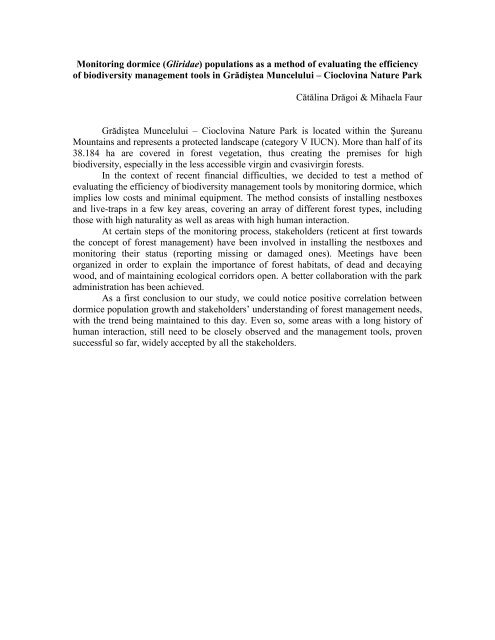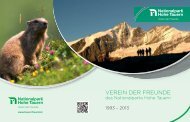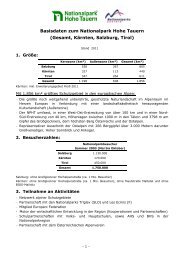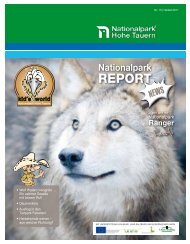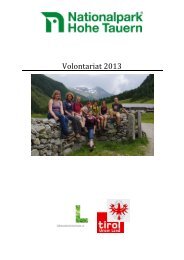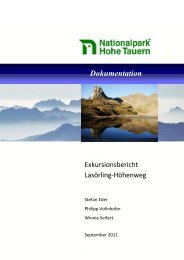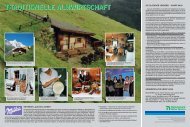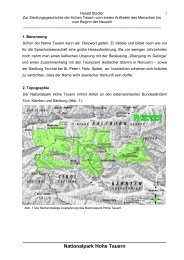Monitoring dormice (Gliridae) populations as a method of evaluating ...
Monitoring dormice (Gliridae) populations as a method of evaluating ...
Monitoring dormice (Gliridae) populations as a method of evaluating ...
You also want an ePaper? Increase the reach of your titles
YUMPU automatically turns print PDFs into web optimized ePapers that Google loves.
<strong>Monitoring</strong> <strong>dormice</strong> (<strong>Gliridae</strong>) <strong>populations</strong> <strong>as</strong> a <strong>method</strong> <strong>of</strong> <strong>evaluating</strong> the efficiency<br />
<strong>of</strong> biodiversity management tools in Grădiştea Muncelului – Cioclovina Nature Park<br />
Cătălina Drăgoi & Mihaela Faur<br />
Grădiştea Muncelului – Cioclovina Nature Park is located within the Şureanu<br />
Mountains and represents a protected landscape (category V IUCN). More than half <strong>of</strong> its<br />
38.184 ha are covered in forest vegetation, thus creating the premises for high<br />
biodiversity, especially in the less accessible virgin and cv<strong>as</strong>ivirgin forests.<br />
In the context <strong>of</strong> recent financial difficulties, we decided to test a <strong>method</strong> <strong>of</strong><br />
<strong>evaluating</strong> the efficiency <strong>of</strong> biodiversity management tools by monitoring <strong>dormice</strong>, which<br />
implies low costs and minimal equipment. The <strong>method</strong> consists <strong>of</strong> installing nestboxes<br />
and live-traps in a few key are<strong>as</strong>, covering an array <strong>of</strong> different forest types, including<br />
those with high naturality <strong>as</strong> well <strong>as</strong> are<strong>as</strong> with high human interaction.<br />
At certain steps <strong>of</strong> the monitoring process, stakeholders (reticent at first towards<br />
the concept <strong>of</strong> forest management) have been involved in installing the nestboxes and<br />
monitoring their status (reporting missing or damaged ones). Meetings have been<br />
organized in order to explain the importance <strong>of</strong> forest habitats, <strong>of</strong> dead and decaying<br />
wood, and <strong>of</strong> maintaining ecological corridors open. A better collaboration with the park<br />
administration h<strong>as</strong> been achieved.<br />
As a first conclusion to our study, we could notice positive correlation between<br />
<strong>dormice</strong> population growth and stakeholders’ understanding <strong>of</strong> forest management needs,<br />
with the trend being maintained to this day. Even so, some are<strong>as</strong> with a long history <strong>of</strong><br />
human interaction, still need to be closely observed and the management tools, proven<br />
successful so far, widely accepted by all the stakeholders.
Long term monitoring <strong>of</strong> grazing in salt habitats on the e<strong>as</strong>tern shore <strong>of</strong> Lake Neusiedl<br />
The landscape <strong>of</strong> the Lake Neusiedel and the Seewinkel w<strong>as</strong> shaped by centuries <strong>of</strong> grazing.<br />
After the virtual collapse <strong>of</strong> the grazing in the 1960s there w<strong>as</strong> a gradual incre<strong>as</strong>e in fallow<br />
land in the Seewinkel and on the shores <strong>of</strong> Lake Neusiedl. As a result <strong>of</strong> decre<strong>as</strong>ed grazing<br />
the reed (Phragmites australis) spread m<strong>as</strong>sively and displaced in v<strong>as</strong>t are<strong>as</strong> a large number<br />
<strong>of</strong> endangered plant and animal species that have benefited from the earlier grazing-regime.<br />
The resumption <strong>of</strong> the grazing with cattle and horses is aimed at restoring a preferably<br />
shrub- and reed-free landscape. Within the National Park Neusiedler See - Seewinkel the<br />
grazing <strong>of</strong> the lakeshore <strong>of</strong> Lake Neusiedl in the so called "cultural landscape zone" is mainly<br />
carried out by herds <strong>of</strong> horses and cattle.<br />
The main problem at the beginning <strong>of</strong> the management, w<strong>as</strong> the then widely held view -<br />
even among nature conservationists - that in large protected are<strong>as</strong>, like National parks, man<br />
should protect natural processes, but not help to maintain man-made conditions also. The<br />
impetus for a more intense and coordinated management came from ornithologists who<br />
noticed a sharp decline in stocks <strong>of</strong> water birds and meadow breeding birds. It w<strong>as</strong> quickly<br />
identified that the lack <strong>of</strong> grazing <strong>of</strong> the lake shores w<strong>as</strong> the main cause for it. In 1990 a<br />
monitoring program h<strong>as</strong> then been established, which should monitor the effects <strong>of</strong> grazing<br />
and regulate the grazing intensity in different focus are<strong>as</strong>.<br />
In this presentation the results <strong>of</strong> long-term monitoring from 1990 to 2011 are presented for<br />
one exemplary site at the paddock <strong>of</strong> Podersdorf. The paddock is situated at the southern<br />
edge <strong>of</strong> Podersdorf and extends over a length <strong>of</strong> approximately 2.5 kilometers to the lookout<br />
tower in the "Illmitzer Hölle". The width <strong>of</strong> the grazed shoreline <strong>of</strong> Lake Neusiedl is between<br />
110 and 220m and varies with the water level <strong>of</strong> the lake by another 20 to 30 meters.<br />
The p<strong>as</strong>tures are dominated by stands <strong>of</strong> purple moor gr<strong>as</strong>s (Molinia caerulea) and head<br />
rush (Schoenus nigricans), which is in phytosociological terms called Junco obtusiflori-<br />
Schoenetum nigricantis. These stands gradually intersperse with the reeds <strong>of</strong> the shoreline,<br />
integrating a narrow strip <strong>of</strong> Cladium mariscus. Landwards salty meadows (Scorzonero<br />
parviflorae-Juncetum gerardii, Atropidetum peisonis) are following, which had been<br />
extended significantly by grazing. Beginning with 1999, a scientific monitoring program h<strong>as</strong><br />
been established there which documents the effects <strong>of</strong> grazing on vegetation, in other parts<br />
<strong>of</strong> the National Park Neusiedler See – Seewinkel monitoring started in 1990. Trends are<br />
detected and interpreted on fixed plots <strong>of</strong> 2x2 meters.<br />
By grazing, the reed (Phragmites australis) w<strong>as</strong> pushed back from the shorline and the<br />
landward salty meadows to the permanently water covered sections <strong>of</strong> the lake by about<br />
200m in about only 10 years.<br />
Looking at the trends in one individual study area, it is evident that the vegetation cover <strong>of</strong><br />
highly competitive species such <strong>as</strong> reed or creeping bentgr<strong>as</strong>s (Agrostis stolonifera) declined<br />
sharply, while typical salt plants recovered and benefited.<br />
1999 2001 2004 2005 2007 2011<br />
Phragmites australis 62,0 12,0 7,3 8,0 4,5<br />
Agrostis stolonifera 44,0 30,0 11,3 6,5 2,5
Cladium mariscus 6,0 4,0 1,3 0,8<br />
Bolboschoenus maritimus 2,9 1,0 1,0 0,3 0,4<br />
Tripolium pannonicum 1,5 0,2 23,3 38,0 12,0 0,2<br />
Juncus gerardii 0,9 1,0 0,3 1,5<br />
Carex distans 1,9 1,4 2,2 0,4<br />
Spergularia maritima 4,5 0,9<br />
Crypsis aculeata 0,4<br />
Chenopodium chenopodioides 0,3<br />
Salicornia prostrata 0,2<br />
The reed w<strong>as</strong> above 60% coverage in the first year <strong>of</strong> observation and declined to 4.5% in<br />
2007. By the rise <strong>of</strong> water level in 2009 and 2010 the site w<strong>as</strong> completely flooded yearover<br />
and the reeds h<strong>as</strong> died out entirely at this site.<br />
Considering the occurrence <strong>of</strong> Pannonian Salt-Aster (Tripolium pannonicum = Aster<br />
tripolium), the species is very rare prior to 2001 and shows only a 0.2 to 1.5 % cover. In the<br />
years with intensive grazing the coverage values incre<strong>as</strong>ed up to 38%. But Tripolium<br />
pannonicum is not only dependent on the presence <strong>of</strong> open land induced by granzing, but<br />
also on the water level <strong>of</strong> Lake Neusiedl. Between 2006 and 2009, the riparian zone under<br />
monitoring w<strong>as</strong> almost all year round water flooded. So Tripolium pannonicum can spread<br />
only in periods <strong>of</strong> low water level, but the rate <strong>of</strong> incre<strong>as</strong>e is clearly accelerated by the<br />
reduction <strong>of</strong> reed.<br />
Remarkably, however, is the re-establishment <strong>of</strong> strict halophytes in the riparian zone. By<br />
grazing, not only open ground w<strong>as</strong> created by phsyical displacement <strong>of</strong> the reed, but also the<br />
accumulation <strong>of</strong> soda in the soil is favoured. A study <strong>of</strong> soil chemistry (KRACHLER et al. 2012, in<br />
preparation) shows that there is a negative correlation for an intact salt budget with the<br />
density <strong>of</strong> vegetation cover. Vegetation prevents the capillary rise and crystallization <strong>of</strong> soda<br />
on the soil surface. The incre<strong>as</strong>e in soda causes that typical halophytes can establish in<br />
locations where they would otherwise not occur for competitive re<strong>as</strong>ons.<br />
Species indicative for high salt concentrations - such <strong>as</strong> the greater sea spurrey (Spergularia<br />
maritima) have established themselves after several years beginning in 2007. In subsequent<br />
years further pioneer species <strong>of</strong> habitats with high salt concentrations followed, so that the<br />
developement <strong>of</strong> a Crypsido aculeatae - Suaedetum maritimae could be initiated.<br />
Characteristic species <strong>of</strong> this <strong>as</strong>sociation such <strong>as</strong> gl<strong>as</strong>swort (Salicornia prostrata), the gr<strong>as</strong>s<br />
Crypsis aculeata and thick leaf goosefoot (Chenopodium chenopodioides) have just been<br />
recorded in the growing se<strong>as</strong>on 2011. Due to the decline <strong>of</strong> reed and bent gr<strong>as</strong>s (Agrostis<br />
stolobifera), there w<strong>as</strong> a greater extent <strong>of</strong> open soil, which w<strong>as</strong> enriched in salts in<br />
consequence to higher evaporation. The best evidence for the successful restoration <strong>of</strong> a<br />
typical salty site w<strong>as</strong> the occurrence <strong>of</strong> large-seepweed (Suaeda pannonica), which w<strong>as</strong> also<br />
first recorded in 2011.<br />
The grazing <strong>of</strong> the reeded lake shore for about 13 years resulted in the the opening <strong>of</strong> the<br />
vegetation cover. Beside highly endangered salt plants species, numerous bird species that<br />
prefer low growing and sparse vegetation also benefited from the grazing. Species such <strong>as</strong><br />
Kentish Plover, little ringed plover, common redshank, avocet and greylag geese (the latter<br />
with large <strong>populations</strong>) are found again in the restored habitats <strong>of</strong> the lakeshores.<br />
Dr. Ingo Korner, 2012-10-15
TITLE: Effect <strong>of</strong> active conservation management on biodiversity: Multi-taxa survey in oak<br />
woodlands <strong>of</strong> Podyji National Park, Czech Republic<br />
AUTHORS: Pavel SEBEK, Michael BARTOS, Jiri BENES, Zuzana CHLUMSKA, Jiri<br />
DOLEZAL, Jakub KOVAR, Blanka MIKATOVA, Michal PLATEK, Simona POLAKOVA,<br />
Martin SKORPIK, Robert STEJSKAL, Filip TRNKA, Mojmir VLASIN, Michal ZAPLETAL &<br />
Luk<strong>as</strong> CIZEK<br />
ABSTRACT<br />
European woodland used to be managed by livestock grazing, coppicing and fire that kept the<br />
forests open and favourable for fauna <strong>as</strong>sociated with open woodland habitats. However, these<br />
practices have been discontinued during the l<strong>as</strong>t two centuries in most <strong>of</strong> Europe. It h<strong>as</strong> lead to<br />
incre<strong>as</strong>ed canopy closure, loss <strong>of</strong> precious habitats and subsequent decre<strong>as</strong>e in biodiversity. This<br />
is also the c<strong>as</strong>e <strong>of</strong> oak woodlands that cover most <strong>of</strong> Podyji (Thayatal) National Park, Czech<br />
Republic. Numerous endangered open woodland specialists, including such emblematic species<br />
<strong>as</strong> the aesculapian snake (Zamenis longissimus), the clouded apollo (Parn<strong>as</strong>sius mnemosyne),<br />
Purpuricenus kaehleri longhorn beetle or the great capricorn beetle (Cerambyx cerdo) are<br />
restricted to forest edges or to remnants <strong>of</strong> the former forest steppes. As a part <strong>of</strong> a restoration<br />
management, small clearings with retention trees (each 40x40 m) were created. Using multi-taxa<br />
survey approach, we observe the recolonisation dynamics. We search for origin <strong>of</strong> species<br />
<strong>as</strong>sociated with clearings in matrix <strong>of</strong> other, locally available habitats. Preliminary results show<br />
that creating gaps in forest canopy is favourable for forest biodiversity. In comparison to closed<br />
canopy forest, the treatment plots generally harbour richer <strong>as</strong>semblages <strong>of</strong> most taxa investigated<br />
(e.g. plants, butterflies, saproxylic beetles, reptiles and birds). However, hands <strong>of</strong>f approach<br />
prevails in management <strong>of</strong> protected woodlands putting emph<strong>as</strong>is on maintaining 'semi-natural'<br />
forests. To avoid further loss <strong>of</strong> biodiversity <strong>as</strong>sociated with open woodlands, it is crucial to<br />
adopt active approaches in conservation management <strong>of</strong> protected forests.<br />
Keywords: endangered species, active conservation, open forest, forest steppe, traditional<br />
silviculture
Sukzessionsprozesse führen zum Verlust von Grünlandflächen im Alpenraum. Doch ist<br />
eine Beweidung von Almen aus naturschutzfachlicher Sicht sinnvoll? Neue Erkenntnisse<br />
aus dem Nationalpark Gesäuse anhand der Indikatorgruppe Zikaden.<br />
Gernot KUNZ<br />
Die extensive Beweidung von Almflächen wird vom Naturschutz nach wie vor als geeignete<br />
Maßnahme zur Erhöhung der Biodiversität und zum Erhalt von Schutzgütern im Alpenraum<br />
gesehen und gefördert. Im Nationalpark Gesäuse wurden die Auswirkungen der<br />
Bewirtschaftung (-sintensität) von beweideten Almflächen im Rahmen eines 10-jährigen<br />
<strong>Monitoring</strong>s anhand der Bioindikatorgruppen Zikaden, Wanzen und Heuschrecken auf fünf<br />
ausgewählten Teilflächen: zwei Niedermoore, ein Hochmoor, ein Kalkmagerr<strong>as</strong>en und eine<br />
Fettweide dokumentiert. Dabei wurden nach den ersten Aufsammlungen in den Jahren 2003<br />
und 2004 ausgewählte Bereiche mit Hilfe von Auszäunungen vor Degradierung durch<br />
Vertritt, zu starkem Verbiss und starker Eutrophierung geschützt. Die mit standardisierten<br />
Methoden 2010 erf<strong>as</strong>sten 2091 Zikadenindividuen aus 35 Arten zeigen in ausgezäunten<br />
Bereichen der Feuchtflächen zum Teil eine Verzehnfachung der Individuenzahl mit einer<br />
Zunahme an Rote Liste Arten. Die Sinnhaftigkeit einer Beweidung im üblichen „extensiven“<br />
Ausmaß wird aus naturschutzfachlicher Sicht anhand der aktuellen Beispiele kritisch<br />
diskutiert.<br />
Mag. Gernot Kunz<br />
Karl Franzens Universität<br />
Universitätsplatz 2, Abt. Zoologie, A 8010 Graz<br />
E-Mail: gernot.kunz@gmail.com; Homepage: http://gernot.kunzweb.net/


